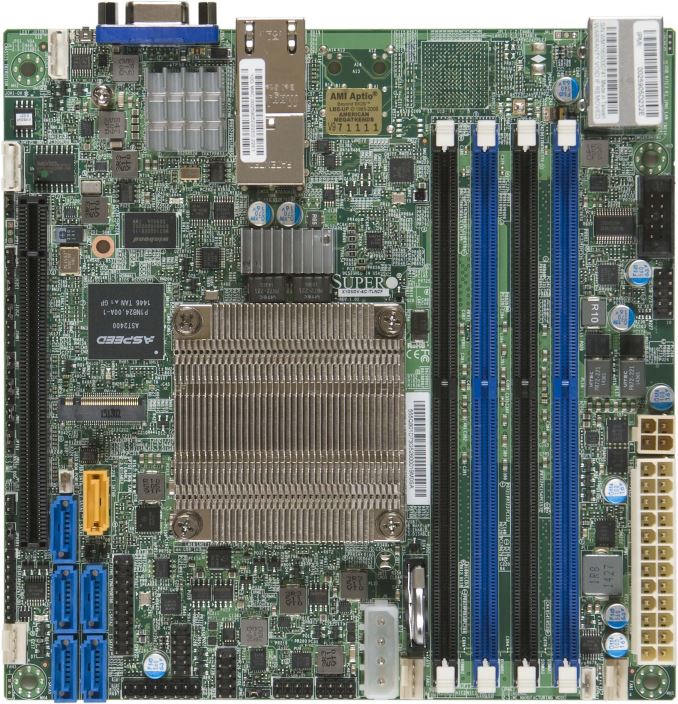Investigating Cavium's ThunderX: The First ARM Server SoC With Ambition
by Johan De Gelas on June 15, 2016 8:00 AM EST- Posted in
- SoCs
- IT Computing
- Enterprise
- Enterprise CPUs
- Microserver
- Cavium
Supermicro's Xeon D Solution: X10SDV-12C-TLN4F
The top tier server vendors seem to offer very few Xeon D based servers. For example, there is still no Xeon D server among the HP Moonshot cartridges as far as we know. Supermicro, on the other hand, has an extensive line of Xeon D motherboards and servers, and is basically the vendor that has made the Xeon D accessible to those of us that do not work at Facebook or Google.
The first board we were able to test was the mini-ITX X10SDV-12C-TLN4F. It is a reasonably priced ($1200) model, in the range what the Gigabyte board and Cavium CN8880 -2.0 will cost (+/- $1100).
The Xeon D makes six SATA3 ports and two 10GBase available on this board. An additional i350-AM2 chip offers 2 gigabit Ethernet ports. The board has one PCI-e 3.0 x16 slot for further expansion. We have been testing this board 24/7 for almost 3 months now. We have tried out the different Ethernet ports and different DDR-4 DIMMS: it is a trouble-free.
The one disadvantage of all Supermicro boards remains their Java-based remote management system. It is a hassle to get it working securely (Java security is a user unfriendly mess), and it lacks some features like booting into the BIOS configuration system, which saves time. Furthermore video is sometimes not available, for example we got a black screen when a faulty network configuration caused the Linux bootup procedure to wait for a long time. Remote management solutions from HP and Intel offer better remote consoles.











82 Comments
View All Comments
JohanAnandtech - Wednesday, June 15, 2016 - link
Good suggestion. I have been using an ipmi client to manage several other servers, like the IBM servers. However, such a GUI client is still a bit more userfriendly, ipmi commands can get complicated if you don't use them regularly. The thing is that HP and Intel's BMC GUI are a lot easier to use and more reliable.fanofanand - Wednesday, June 15, 2016 - link
I think you may have an inaccurate figure of 141 at idle (in the graph) for the Thunder. "makes us suspect that the chip is consuming between 40 and 50W at idle, as measured at the wall"JohanAnandtech - Wednesday, June 15, 2016 - link
If you look at the Column "peak vs idle", you see 82W. At peak, we assume that a 120W TDP chip will probably need about 130W. 130W - 82W (both measured at the wall) = 50W for the SoC alone at idle measured at the wall, so anywhere between 40-50W in reality. My Calculation is a "guestimate", but it is clear that the Cavium chip needs much more in idle than the Intel chips.(10-15W) .djayjp - Wednesday, June 15, 2016 - link
Many spelling/grammar issues here. It impacts readability. Please read before posting.djayjp - Wednesday, June 15, 2016 - link
That is to say in the article.mariush - Wednesday, June 15, 2016 - link
These guys are already working on ThunderX2 (54 cores, 3 Ghz , 14nm , ARMv8) and they already have functional chips : https://www.youtube.com/watch?v=ei9uVskwPNEMeteor2 - Thursday, June 16, 2016 - link
It's always jam tomorrow, isn't it? Intel is working on new chips too, you know.beginner99 - Wednesday, June 15, 2016 - link
It loses very clearly in performance/watt to Xeon-D. In this segment the lower price doesn't matter in that case and the fact that it has a process disadvantage doesn't matter either. What counts is the end result. And I doubt it would cost $800 if made on 14/16nm. I mean why would anyone buying this take the risk? Safer bet to go with Intel also due to more flexible use (single and multi threaded). The latency issue is mentioned but downplayed.blaktron - Wednesday, June 15, 2016 - link
So downplayed. Anandtech desperately wants ARM servers, but its a solution looking for a problem. Big web front ends running on bare metal are such a small percentage of the server market that developing for it seems stupid. Xeon-D was already in development for SANs, they just repurposed it for docker and nginx.Senti - Wednesday, June 15, 2016 - link
Very nice article. I especially liked the emphasis on relations of test numbers and real world workloads and what was problematic during the testing.It would be great to see the same style desktop CPU review (Zen?) form you instead of mix of reprinted marketing hype with silly benchmark numbers dump that plagues this site for quite some time now.
Some annoying typos here and there, like "It is clear that the ThunderX is a match for high frequency trading", but nothing really bad.